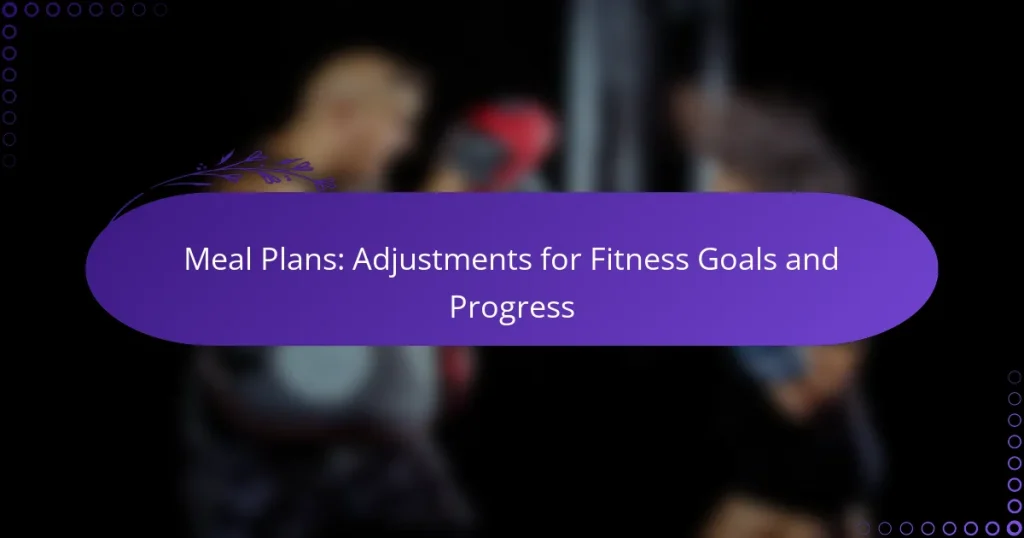Meal plans play a crucial role in achieving fitness goals by allowing for specific adjustments in caloric intake, macronutrient distribution, and meal timing. By tailoring nutrition to individual needs, these plans can enhance energy levels, support muscle growth, and facilitate fat loss, ultimately optimizing overall performance and results.

How can meal plans be adjusted for fitness goals?
Meal plans can be tailored to meet specific fitness goals by adjusting caloric intake, macronutrient distribution, and meal timing. Understanding these adjustments helps individuals optimize their nutrition for weight loss, muscle gain, endurance, and overall performance.
Caloric deficit for weight loss
A caloric deficit occurs when you consume fewer calories than your body expends, leading to weight loss. To create this deficit, aim to reduce daily caloric intake by about 500 to 750 calories, which can result in a safe weight loss of around 0.5 to 1 kg per week.
Focus on whole foods like vegetables, lean proteins, and whole grains while minimizing processed foods and sugary snacks. Tracking your food intake can help ensure you maintain the desired deficit without feeling deprived.
Increased protein for muscle gain
For muscle gain, increasing protein intake is essential. Aim for approximately 1.6 to 2.2 grams of protein per kilogram of body weight daily to support muscle repair and growth. This can be achieved through sources like chicken, fish, legumes, and dairy.
Incorporating protein-rich snacks post-workout can further enhance muscle recovery. Consider options like Greek yogurt, protein shakes, or cottage cheese to meet your protein needs effectively.
Balanced macros for endurance training
Endurance training requires a balanced intake of carbohydrates, proteins, and fats to sustain energy levels. A common macronutrient ratio for endurance athletes is 60% carbohydrates, 20% protein, and 20% fat, which supports prolonged physical activity.
Focus on complex carbohydrates such as whole grains, fruits, and vegetables to fuel your workouts. Regularly consuming small meals or snacks throughout the day can help maintain energy levels and prevent fatigue during training sessions.
Meal timing for performance
Meal timing can significantly impact performance, especially around workouts. Consuming a balanced meal or snack containing carbohydrates and protein 1-3 hours before exercise can enhance energy levels and endurance.
Post-workout, aim to eat within 30 to 60 minutes to optimize recovery. A combination of protein and carbohydrates, such as a protein shake with a banana, can replenish glycogen stores and aid muscle repair.
Hydration strategies
Staying hydrated is crucial for optimal performance and recovery. Aim to drink at least 2 to 3 liters of water daily, adjusting based on activity level and climate. During intense workouts, consider electrolyte-rich drinks to replace lost minerals.
Monitor your hydration status by checking the color of your urine; pale yellow indicates proper hydration. Make a habit of drinking water before, during, and after exercise to maintain fluid balance and support overall health.

What are popular meal planning tools?
Popular meal planning tools help individuals organize their meals according to specific dietary goals and preferences. These tools can assist with tracking nutrition, automating meal suggestions, and customizing plans to fit personal needs.
MyFitnessPal for tracking
MyFitnessPal is a widely used app that allows users to track their food intake and exercise. It features a vast database of foods, making it easy to log meals and monitor nutritional values such as calories, macronutrients, and micronutrients.
To effectively use MyFitnessPal, set a daily calorie goal based on your fitness objectives. Regularly logging your meals can help identify patterns and areas for improvement, ensuring you stay on track with your nutrition.
Eat This Much for automation
Eat This Much is an automated meal planning tool that generates meal suggestions based on your dietary preferences and goals. Users can input their calorie targets, dietary restrictions, and food preferences, and the app will create a customized meal plan.
This tool is particularly useful for those who want to save time on meal prep. By automating the planning process, Eat This Much helps users discover new recipes while ensuring they meet their nutritional needs without excessive effort.
PlateJoy for customization
PlateJoy focuses on personalized meal planning by considering individual dietary preferences, health goals, and cooking habits. After completing a detailed questionnaire, users receive tailored meal plans that can be adjusted based on seasonal ingredients or specific dietary needs.
PlateJoy also offers grocery lists that streamline shopping, making it easier to stick to your meal plan. This tool is ideal for those who want a highly customized approach to their nutrition while minimizing food waste and maximizing variety.

How do meal plans impact fitness progress?
Meal plans significantly influence fitness progress by providing structured nutrition tailored to individual goals. A well-designed meal plan can enhance energy levels, support muscle growth, and aid in fat loss, ultimately leading to better results in fitness endeavors.
Consistency leads to results
Maintaining consistency with meal plans is crucial for achieving fitness goals. Regularly following a structured eating regimen helps establish healthy habits, making it easier to meet nutritional needs and stay on track with progress. For instance, sticking to a meal plan that includes balanced macronutrients can lead to steady weight loss or muscle gain over time.
To foster consistency, consider meal prepping for the week ahead. Preparing meals in advance can reduce the temptation to stray from the plan and ensure that healthy options are readily available.
Tracking progress with meal logs
Using meal logs is an effective way to monitor dietary intake and its impact on fitness progress. By recording what you eat, you can identify patterns, assess portion sizes, and make informed adjustments. This practice can reveal whether you are meeting your caloric and macronutrient targets.
To get started, choose a method that works for you, such as a mobile app or a simple notebook. Aim to log meals consistently for at least a few weeks to gather meaningful data about your eating habits.
Adjusting plans based on feedback
Regularly reviewing your meal plan based on feedback from your body and progress is essential for ongoing success. If you notice stagnation in weight loss or muscle gain, it may be time to adjust caloric intake or macronutrient ratios. Listening to your body’s signals can guide these changes effectively.
Consider setting checkpoints every few weeks to evaluate your progress. If results are not aligning with your goals, consult a nutritionist or dietitian to help refine your meal plan based on your specific needs and feedback.

What criteria should be considered when choosing a meal plan?
When selecting a meal plan, it’s essential to consider dietary preferences, fitness goals, and budget constraints. These factors ensure that the plan is not only effective but also sustainable and enjoyable.
Dietary preferences and restrictions
Your meal plan should align with your dietary preferences and any restrictions you may have. For instance, if you are vegetarian, vegan, or have allergies to certain foods, the plan must accommodate these needs to avoid health issues and ensure satisfaction.
Consider the types of cuisine you enjoy and how they can be incorporated into your meal plan. This can help maintain motivation and adherence over time. For example, if you prefer Mediterranean dishes, look for plans that emphasize fruits, vegetables, whole grains, and healthy fats.
Fitness goals alignment
It’s crucial that your meal plan aligns with your specific fitness goals, whether it’s weight loss, muscle gain, or improved endurance. Each goal requires different macronutrient ratios and calorie intakes. For example, a plan for muscle gain may focus on higher protein intake, while a weight loss plan may prioritize lower calorie consumption.
Assess your current progress and adjust your meal plan accordingly. Regularly tracking your results can help you determine if you need to increase or decrease your caloric intake or modify your macronutrient distribution.
Budget considerations
Your budget plays a significant role in choosing a meal plan. It’s important to find a plan that fits within your financial means while still providing nutritious options. Meal prepping can be a cost-effective strategy, allowing you to buy ingredients in bulk and reduce food waste.
Consider the cost of ingredients and whether the plan requires specialty items that may be expensive or hard to find. Aim for a balance between quality and affordability; for instance, prioritize whole foods over processed items to maximize nutritional value without overspending.

What are common meal plan mistakes to avoid?
Common meal plan mistakes include neglecting portion sizes, failing to account for nutritional balance, and not adjusting plans based on progress. These errors can hinder fitness goals and lead to frustration.
Neglecting portion sizes
One of the most frequent mistakes in meal planning is overlooking portion sizes. Consuming larger portions than necessary can lead to excessive calorie intake, which may counteract weight loss efforts. Use measuring cups or a food scale to ensure you’re serving appropriate amounts.
To avoid this pitfall, consider using smaller plates or bowls to help control portions visually. Aim for balanced meals that include a variety of food groups while keeping an eye on serving sizes.
Failing to account for nutritional balance
Another common error is not ensuring a balanced intake of macronutrients—proteins, fats, and carbohydrates. Each macronutrient plays a crucial role in supporting energy levels and overall health. A meal plan lacking in one or more of these can lead to fatigue and nutrient deficiencies.
To maintain nutritional balance, aim for meals that include lean proteins, healthy fats, and whole grains. A simple guideline is to fill half your plate with vegetables, a quarter with protein, and the remaining quarter with whole grains.
Not adjusting plans based on progress
Failing to modify meal plans as fitness goals progress is a significant mistake. As your body adapts to a routine, caloric needs may change, requiring adjustments to your meal plan. Regularly assess your progress and be willing to make changes to your diet.
Consider tracking your meals and results to identify patterns. If weight loss stalls or energy levels drop, it may be time to tweak your calorie intake or macronutrient ratios. Regular check-ins can help keep your meal plan aligned with your fitness objectives.


